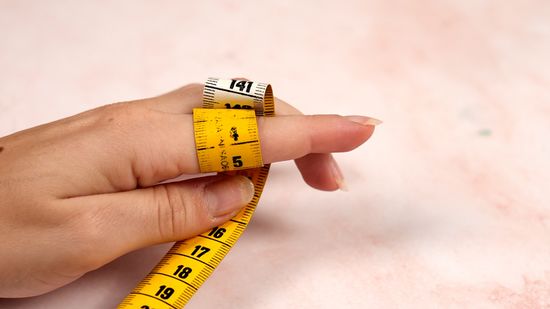Finding the Perfect Fit: A Comprehensive Guide to Measuring Ring Size with a Tape Measure
Selecting a ring is a momentous occasion, symbolizing love, commitment, or a personal milestone. But ensuring the perfect fit can sometimes feel like a mystery. While printable ring size charts and online guides offer some assistance, physically measuring your finger with a tape measure provides the most accurate way to determine your ring size. This comprehensive guide delves into the process of measuring your finger for a ring, ensuring a comfortable and confident fit for your new treasure.
Why Measure with a Tape Measure?
While ring size charts offer a general guideline, they can be imprecise. Factors like finger knuckle size and variations between brands and ring styles can lead to inconsistencies. Measuring your finger directly with a tape measure provides a more accurate representation of your unique finger size.
Tools and Preparation
Before embarking on your ring-sizing adventure, gather the following:
- Flexible, non-stretching tape measure: A tailor’s tape measure, typically made of cloth or thin plastic, is ideal. Avoid using a metal tape measure, as it can be uncomfortable and may bend or provide inaccurate readings.
- Pen and paper: To note down your measurements for future reference.
- Warm water (optional): Soaking your fingers in warm water for a few minutes can slightly expand them, especially if you’re measuring later in the day when fingers tend to be slightly bigger. (Avoid extreme hot water, though, as it can be uncomfortable.)
Understanding Your Finger Anatomy
To ensure an accurate measurement, it’s helpful to understand some basic finger anatomy:
- Base of the finger: The narrowest part of your finger, typically located just below the knuckle joint. This is the ideal spot to measure for ring size.
- Knuckle: The wider joint at the top of your finger. Rings need to comfortably slide over the knuckle to avoid getting stuck.
Measuring Your Finger
Here’s a step-by-step guide to measuring your finger for a ring:
- Choose the right finger: If you’re unsure which finger the ring will be worn on, consider the intended purpose. Engagement rings are traditionally worn on the fourth finger of the left hand, while wedding bands are often placed next to them. However, some people choose to wear rings on other fingers.
- Warm up your fingers (optional): If needed, soak your fingers in warm water for a few minutes to achieve a more accurate measurement, especially if measuring later in the day.
- Wrap the tape measure: Gently wrap the tape measure around the base of your chosen finger. The tape should fit snugly but comfortably, not too loose or constricting. Avoid wrapping the tape over your knuckle, as this can lead to an inaccurate measurement.
- Measure twice, cut (or write) once: Make sure the tape measure is level and record the measurement in millimeters (mm) on your piece of paper. It’s advisable to repeat the measurement 2-3 times to ensure accuracy. If the measurements differ slightly, take the average of the closest readings.
Understanding Your Measurements
Once you have your measurement in millimeters, you can use a ring size conversion chart to find your corresponding ring size. Conversion charts are readily available online or you can find them on some retailer websites.
Here are some things to keep in mind when using a conversion chart:
- Ring size variations: Ring sizes can vary slightly between countries (US, UK, Australia, etc.). The conversion chart you use should specify which sizing system it corresponds to.
- Half sizes: Not all rings come in whole sizes. If your measurement falls between two sizes, it’s generally recommended to choose the larger size for comfort, especially for wider bands.
Additional Tips for Accurate Measurement
- Measure at the end of the day: Fingers tend to swell slightly throughout the day. Measuring later in the afternoon or evening can provide a more accurate idea of how the ring will fit throughout the day.
- Measure multiple fingers: Finger sizes can vary slightly between your dominant and non-dominant hand. It’s advisable to measure both hands, especially if you’re unsure which finger will wear the ring.
- Consider knuckle size: If you have large knuckles, it might be helpful to measure both the base of your finger and the widest part of your knuckle. This can help ensure the ring slides on comfortably.
When to Seek Professional Help
While measuring your finger with a tape measure is a practical approach, there can be situations where seeking professional guidance is recommended:
- Wide bands or unusual ring shapes: Wider bands or rings with non-traditional shapes may require a slightly different fit than standard rings.






More Stories
Where to Watch USMNT vs Jamaica National Football Team
How I Met My Monster
How Should a Ring Fit